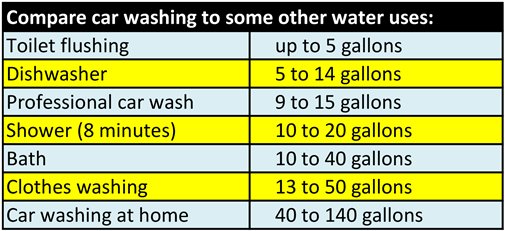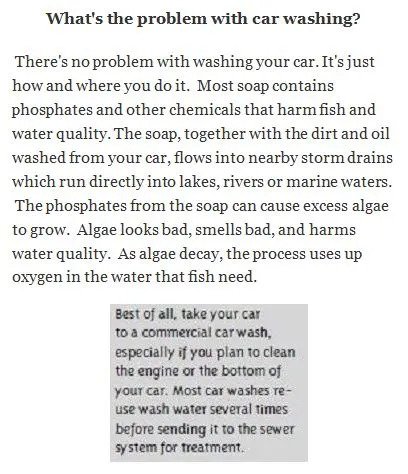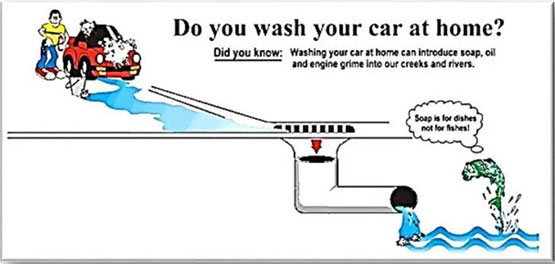Professional Car Washing vs. Washing at Home
Carbutler uses an average of 10 gallons of water per vehicle — a fraction of an at-home wash.
At Carbutler, water conservation and purification is integral to our process. Every drop of our used water is processed through our patented Hybrid Oil Interceptors to separate grit, oil and grease from the wash water. This filtration exceeds EPA requirements and units have been sold to the city of Houston to filter city water. Separated sediments are taken off-site to be treated by a third-party company. The remaining water flows to our local Sanitary Authority for treatment regulated by the EPA. Carbutler purchases recycled products and supplies. In fact, every product used at Carbutler is formulated to be environmentally responsible.

Water Usage Examples
Washing a car at home in the driveway or at a parking lot fundraiser will use between 40 and 140 gallons of water on a single car. The lower estimate assumes the use of a bucket and spray nozzle. The higher is a free flowing hose.


What Happens to Carwash Water at Home?
Cars that are washed in the street can pollute our rivers and harbors. The soapy water that runs off the car into the gutters goes into the storm water system. Storm water, unlike the water which enters the sewers, does not undergo treatment before it is discharged into our waterways. Any pollutants in storm water end up in our lakes, rivers, bayous, harbors and oceans. Polluting waterways in this way is a breach of the Protection of the Environment Operations Act 1997 and could actually result in a $750 fine for individuals or a $1500 fine for corporations.
How big is the problem?
The waste water that runs off a car when it is washed contains a range of substances that may pollute the environment. These include soaps and detergents, mud, rubber particles, grease and road grime (oil, tar, dirt).
These substances flow untreated into the storm water system and eventually find their way into our lakes, rivers, bayous, harbors and oceans – wherever the storm water discharges. All of these substances are harmful to fish and other marine life.
According to the Federal Highway Administration there were 19,661,400 vehicles registered in Texas in 2013. If every vehicle was washed only once a year with 40 gallons of water (5 buckets), over 786 million gallons of polluted water could enter the storm water system every year.
How to Cut Home Water Waste
Here are some ideas from Earthshare.org
The world’s dwindling water resources are being used by a growing population with increasing demands. Believe it or not, most of the US is expected to face water shortages in the coming years; 26 states were declared natural disaster areas by the USDA in July 2012 due to drought conditions.
According to EarthShare member organization Food & Water Watch, the average American uses 1.190 gallons of water per day. Much of that is hidden inside the products we buy, the energy we use and the food we eat, but our laundry, hygiene, dish washing, habits also use more than the global average.
Here are some simple, inexpensive ways to cut back on water use at home:
Use less water: one of the clearest steps toward water conservation is also the most obvious one — simply use less. Start by taking shorter showers, filling up the dishwasher and laundry machines before you run them, and turning off the faucet while brushing your teeth.
Check for leaks: look at faucets and pipes to make sure water isn’t escaping.
Choose smart appliances: water-saving shower heads, low-flow toilets, and faucet aerators can lower your water bill.
Plant drought-resistant vegetation: some native plants, shrubs, and trees require less watering. Consider xeriscaping — landscaping and gardening in ways that reduce or eliminate the need for supplemental water from irrigation. The traditional turf lawn is one of the most environmentally unfriendly types of landscaping! For houseplants, try using water leftover from cooking instead of running the faucet again.
Go renewable: Half of the water we use goes to power generation. Renewable sources like solar and wind use significantly less water than coal and nuclear. Make the switch.
Fill up a water bottle: instead of buying disposable plastic water bottles, fill up a refillable water container to decrease the energy used in producing, transporting, and disposing plastic bottles.
Avoid buying new “water-intensive” products: cotton, electronics and paper all require a lot of water in their production. Try buying used clothing and recycled paper whenever possible and resist the urge to get the latest gadget every year if your existing device is in working order.